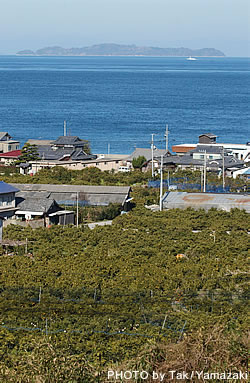 The
Seto Inland Sea, in Japanese Seto-naikai or Setouchi, has a
sea area of 21827 sq km and lies in West Japan between the main
islands of Honshu, Shikoku, and Kyushu. It is linked to the
Sea of Japan and the Pacific Ocean by narrow channels. The shallow
sea, with an average depth of 38m, is dotted with more than
950 islands, the largest of which is Awaji-shima. The Inland
Sea is famed for its scenic beauty and is the site of Inland
Sea National Park (660 sq km; established 1934) which includes
some 600 islands and coastal segments. The
Seto Inland Sea, in Japanese Seto-naikai or Setouchi, has a
sea area of 21827 sq km and lies in West Japan between the main
islands of Honshu, Shikoku, and Kyushu. It is linked to the
Sea of Japan and the Pacific Ocean by narrow channels. The shallow
sea, with an average depth of 38m, is dotted with more than
950 islands, the largest of which is Awaji-shima. The Inland
Sea is famed for its scenic beauty and is the site of Inland
Sea National Park (660 sq km; established 1934) which includes
some 600 islands and coastal segments.
Look at the map and imagine sea levels 120m below as they were
10000 years ago - isn't it easy to imagine that the many islands
were mountain tops? The area is made up of mountain ranges running
North-South, nowadays forming island chains, and large basins,
now stretches of open sea. Tide flows come in twice a day from
the Eastern and Western end, so for an enclosed sea, water exchange
is relatively good. The area has a mild climate with an average
temperature of 15 degree C. With 1000-1600mm rain per year,
mainly falling in June and September, it is rather dry compared
to other areas of Japan. Summer is hot and humid, but winter
has many sunny and dry days, ideal for cycling or hiking. |
 The
shores of the Inland Sea are heavily populated and are part
of Japan's most important industrial belt; many of Japan's greatest
ports, including Osaka, Kobe, and Hiroshima are situated here.
Urbanisation and industrialization have left their scars. At
the end of the 19th century, mountains and islands were deprived
of trees, as wood was not only used for daily life but also
for salt-production along the coast. Fields and orchards, now
restricted to the lower slopes, climbed all the way up the islands,
trying to squeeze some food out of the crumbly soil. In the
1960s, even the water was heavily polluted and unrestricted
land reclamation ate away at the sea-surface. In 1973, legislation
was introduced that led to cleaner water and a slower pace of
reclamation. Nowadays, the Inland Sea also has many success
stories of environmental restoration. Even one of the traditional
landscapes representative of this area, white beaches and green
pine trees, is man-made: beaches formed when deforestation led
to soil erosion, and pines were planted as fast-growing trees.
So don't expect wilderness, but the beauty - and sometimes ugliness
- created by human interaction with nature, a cultural landscape
grown over the centuries. The
shores of the Inland Sea are heavily populated and are part
of Japan's most important industrial belt; many of Japan's greatest
ports, including Osaka, Kobe, and Hiroshima are situated here.
Urbanisation and industrialization have left their scars. At
the end of the 19th century, mountains and islands were deprived
of trees, as wood was not only used for daily life but also
for salt-production along the coast. Fields and orchards, now
restricted to the lower slopes, climbed all the way up the islands,
trying to squeeze some food out of the crumbly soil. In the
1960s, even the water was heavily polluted and unrestricted
land reclamation ate away at the sea-surface. In 1973, legislation
was introduced that led to cleaner water and a slower pace of
reclamation. Nowadays, the Inland Sea also has many success
stories of environmental restoration. Even one of the traditional
landscapes representative of this area, white beaches and green
pine trees, is man-made: beaches formed when deforestation led
to soil erosion, and pines were planted as fast-growing trees.
So don't expect wilderness, but the beauty - and sometimes ugliness
- created by human interaction with nature, a cultural landscape
grown over the centuries. |
Links:
General information on the environment of the Seto Inland Sea:
http://www.seto.or.jp/setokyo/eng/e-toppage/e-topage.htm
Information on National Parks in Japan by the Ministry of Environment:
http://www.env.go.jp/en/nature/nps/np.html
Information on Setonaikai National Parks by the Ministry of
Environment:
http://www.biodic.go.jp/english/jpark/np/seto_e.html |

